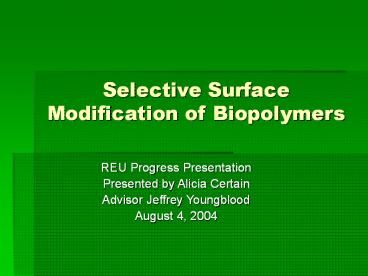Selective Surface Modification of Biopolymers - PowerPoint PPT Presentation
Title:
Selective Surface Modification of Biopolymers
Description:
... Selective Surface Modification of Biopolymers Polymers vs. Biopolymers Wettability and Applications The First Biopolymer The Next Polymer Modification ... – PowerPoint PPT presentation
Number of Views:216
Avg rating:3.0/5.0
Title: Selective Surface Modification of Biopolymers
1
Selective Surface Modification of Biopolymers
- REU Progress Presentation
- Presented by Alicia Certain
- Advisor Jeffrey Youngblood
- August 4, 2004
2
Polymers vs. Biopolymers
- Familiar examples garbage bags, milk jugs, car
bumpers, motor oil, carpet fibers, plumbing pipes - Biopolymers The green materials
- Made from renewable resources
- Biodegradable
- Have different properties than traditional
polymers
3
Wettability and Applications
- An increase in wettability would be desirable for
applications such as textiles, cleaning wipes,
household fabrics - A decrease in wettability would be desired for
packaging
4
The First Biopolymer
- Family of polyhydroxyalkanoates (PHAs)
- Worked with poly(lactic acid) (PLA)
- Trade name Natureworks
- Produced from corn
5
The Next Polymer
- From the family of 1,3, propanediol
- Specific polymer is poly(propylene-terephthalate)
(PPT) - Trade name Sorona
- Also comes from corn
6
Modification of Biopolymers
- Samples were spin coated onto glass slides
- Goal was to modify the surface of the polymers in
order to change wettability - Worked with three chemical modifications
- APTES
- Hydrolysis
- Aminolysis
7
APTES modification
- 3-aminopropyltriethoxysilane
- Previously used to modify PET
- Increased wettability
- What will it do to biopolymers?
8
Hydrolysis
- Immersion in aqueous alkaline base
- Breaks up chain, adding hydroxyl group to one
end, hydrogen to the other - Should increase wettability
- Simplest procedure
9
Aminolysis
- Similar to hydrolysis, using an amine instead
- Tried n-butylamine, which is known to increase
wettability in PET very slow! - Used n-lithiodiamine to decrease reaction times
10
Contact Angle Analysis
- Liquid drop on solid surface modifies its shape
based on the interfacial tensions - Creates a material property of the system called
the contact angle
11
Characterization
- Contact angle measurements primary
characterization - Tests done through the goniometer
- AFM imaging used to augment
12
Wettability Results
13
Untreated PLA
14
2 minutes
15
15 minutes
16
Optimal Times
17
Wettability Results
18
Contact Angles
30 minutes
15 minutes
45 minutes
19
Wettability Results
20
Wettability Results
21
PPT and APTES
- Most successful in decreasing wettability
- 6 hours led to approx. 55 degree advancing, 0
receding - 24 hours led to approx. 45 degree advancing, 0
receding - 72 hours created an increase back to approx. 60
advancing, 0 receding
22
Flourinated APTES
- 24 hour APTES reaction on PLA with concentration
cut in half - Subsequent reaction with tridecaflouro-1,1,2,2-tet
rahydrooctyltri-chlorosilane - APTES on PLA only increases wettability slightly,
but surface is functionalized and flourination
successfully decreases wettability
23
Possible Future Directions
- APTES optimization
- Pinpointing a more definite optimum PLA
hydrolysis time - Vapor phase reactions
- Subsequent reactions on functionalized surfaces
to increase hydrophobicity rather than decrease
24
Thanks!
- Prof. Youngblood and Prof. Kvam
- John, Ben, and Phil
- Allen and Kendra
- The REU Group































